Backgrounder: More Jobs, a Growing Economy, and a Stronger Middle Class
Backgrounder
Today, Canada leads all Group of Seven (G7) countries in economic growth and Canadians are feeling more confident about the future—whether their plan is to save for a first home, pay down their debt, or go back to school to train for a new job. As a result, the Government is about to invest in the things that matter to Canadians, while making steady improvements to the Government's bottom line.
Canada's strong fiscal fundamentals—anchored by a low and consistently declining debt-to-GDP (gross domestic product) ratio—means that Canada can make the investments that will strengthen and grow the middle class, and lay a more solid foundation for our children's future.
According to the International Monetary Fund (IMF), Canada's net debt-to-GDP ratio is by far the lowest among G7 countries and less than half the G7 average.
The Government's investments in people and in the communities they call home are delivering greater opportunities for the middle class, and for all Canadians. Targeted investments, combined with the hard work of Canadians, have helped create good, well-paying jobs—and will continue to strengthen the economy over the long term.
Measures like the middle class tax cut and the Canada Child Benefit have provided Canadian families with more money to save, invest, and spend in their communities. Historic investments in public transit, green infrastructure, and social infrastructure—such as early learning and child care and affordable housing—combined with investments in an ambitious Innovation and Skills Plan and the significant steps we are taking to achieve equality, will ensure that Canadians have the support they need to compete and succeed.
Budget 2018 builds on this plan of investment, while maintaining a clear focus on fiscal responsibility and continuously improving fiscal results.
Canadian Economic Context
The Government's plan to invest in people, in communities, and in the economy has put more money in the pockets of Canadians, has helped create more well-paying jobs, and is giving Canadians greater confidence in their future.
Since November 2015, Canadians have created almost 600,000 new jobs and the unemployment rate has fallen from 7.1 per cent to 5.9 per cent—close to its lowest level in over four decades. The Canadian economy has been remarkably strong, growing at a pace well above that of all other G7 countries since mid-2016 (Chart 1).
Chart 1
Labour Market Since November 2015
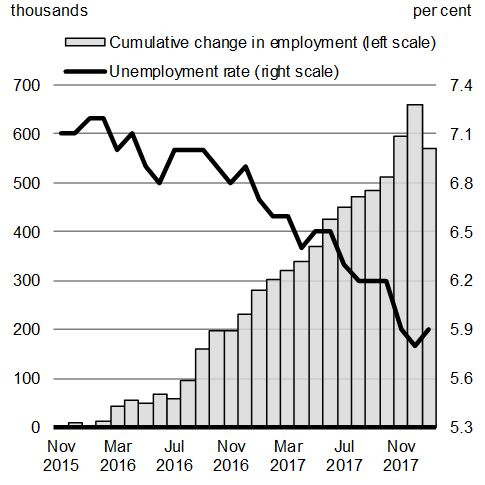
Note: Last data point is January 2018.
Source: Statistics Canada.
Average Real GDP Growth Since 2016Q2
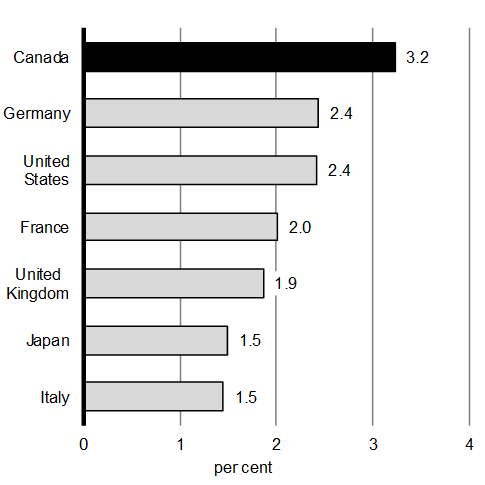
Notes: Average quarterly real GDP growth. Last data point is 2017Q4 except for Canada, for which it is 2017Q3.
Source: Haver Analytics.
Strong output growth and a robust labour market—along with the measures that the Government has put in place to support the middle class over the past two years—are driving higher levels of Canadian consumer and business confidence and supporting wage growth (Chart 2). This positive sentiment and higher earnings are translating into solid growth in household spending and a recovery in business investment, which should continue to support economic growth.
Chart 2
Real Household Consumption Growth and Consumer Confidence
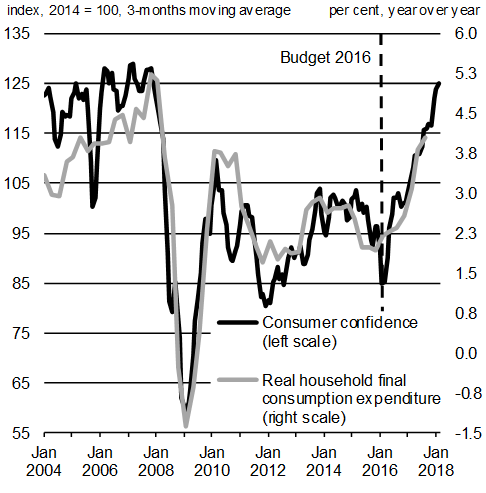
Note: Last data points are 2017Q3 for consumption and January 2018 for consumer confidence.
Sources: Statistics Canada; The Conference Board of Canada.
Growth in Average Weekly Earnings
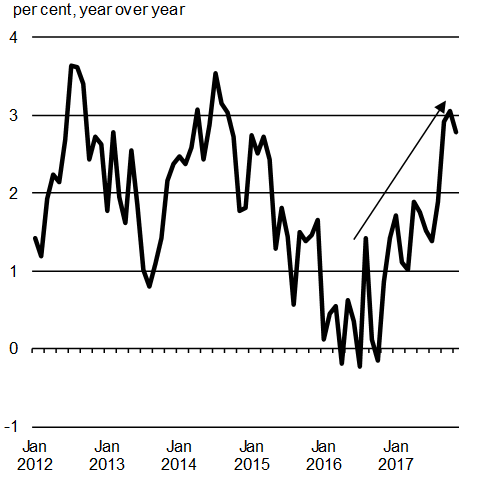
Note: Last data point is November 2017.
Source: Statistics Canada, Survey of Employment, Payroll and Hours (SEPH).
Going forward, growth is expected to remain robust. However, risks remain that could affect the economic outlook—underscoring the importance of continuing to make responsible investments.
Budget 2018 Investments
Through Budget 2018, the Government continues to strengthen the middle class and make investments to support Canada's long-term economic growth. Challenges posed by population aging, global climate change, and rapid technological innovation underscore the importance of strong leadership and a forward-looking approach to continue growing the middle class and ensuring all Canadians are able to contribute to—and benefit from—Canada's prosperity.
Budget 2018 continues the Government's plan to invest in the middle class and puts a special focus on ensuring that all Canadians have the skills and opportunities they need to participate fully and equally in our economy. Budget 2018 also makes investments to ensure equality for women and men, position Canada at the forefront of scientific and technological innovation, protect Canada's natural heritage, and create more opportunities for Indigenous Peoples.
Maintaining a Downward Deficit Track
Growth-generating investments in people, in communities, and in the economy are balanced by sound fiscal management. The Budget 2018 fiscal track is broadly unchanged from the 2017 Fall Economic Statement and continues to show a decline in the federal debt-to-GDP ratio, along with steady improvements in the Government's annual budgetary balance (Charts 3 and 4).
The federal debt-to-GDP ratio is projected to decline over the forecast horizon, reaching 28.4 per cent in 2022–23. According to the IMF, Canada's net debt-to-GDP ratio is by far the lowest among G7 countries and less than half the G7 average (Chart 3).
Chart 3
Federal Debt-to-GDP Ratio
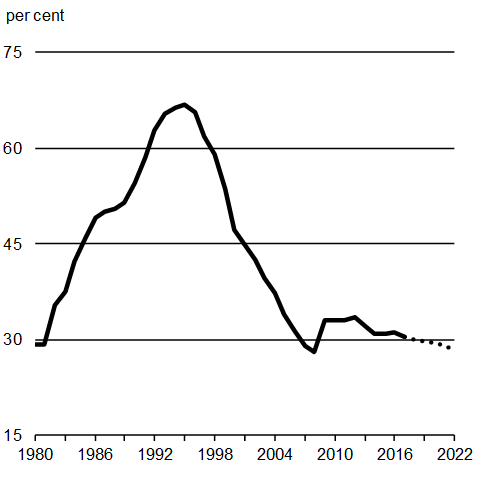
Sources: Public Accounts of Canada; Statistics Canada;
Department of Finance Canada calculations.
IMF Forecast for General Government Net Debt-to-GDP Ratios, 2017
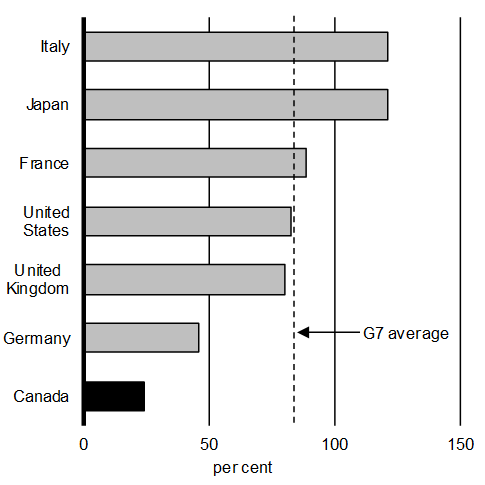
Notes: The general government net debt-to-GDP ratio is the ratio of total liabilities, net of financial assets, of the central, state and local levels of government, as well as
those in social security funds, to GDP. For Canada, this includes the federal, provincial/territorial and local government sectors, as well as the Canada Pension Plan and the Quebec Pension Plan.
Source: IMF, October 2017 Fiscal Monitor.
The Government will maintain this downward deficit and debt ratio track—preserving Canada's low-debt advantage for current and future generations. Low debt supports economic growth and intergenerational equity by keeping interest costs low and preserving flexibility to face future challenges and shocks.
Chart 4
Budgetary Balance
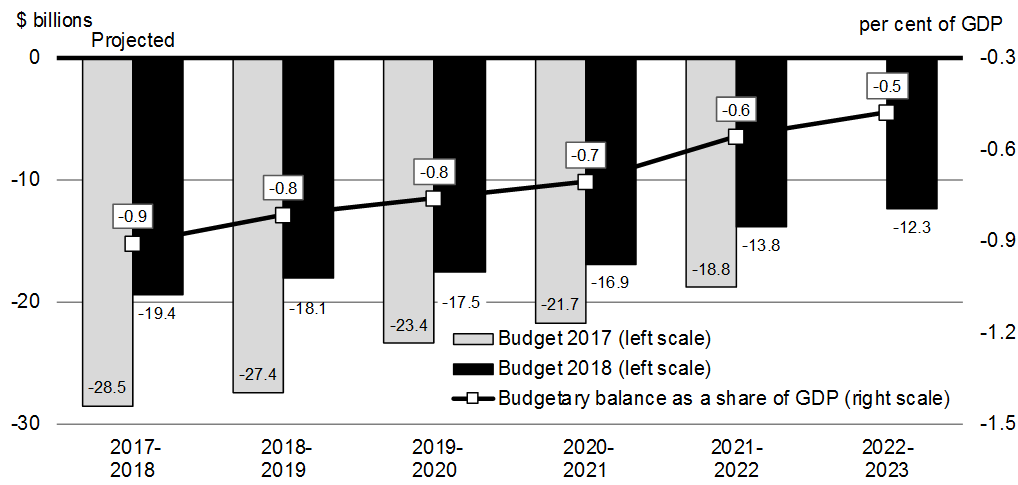
Source: Department of Finance Canada.
| Projection | ||||||
|---|---|---|---|---|---|---|
| 2017– 2018 |
2018– 2019 |
2019– 2020 |
2020– 2021 |
2021– 2022 |
2022– 2023 |
|
| FES 2017 budgetary balance | -19.9 | -18.6 | -17.3 | -16.8 | -13.9 | -12.5 |
| Adjustment for risk from FES 2017 | 1.5 | 3.0 | 3.0 | 3.0 | 3.0 | 3.0 |
| FES 2017 budgetary balance (without risk adjustment) | -18.4 | -15.6 | -14.3 | -13.8 | -10.9 | -9.5 |
| Economic and fiscal developments since FES 2017 | 3.0 | 3.6 | 4.1 | 3.5 | 2.8 | 2.8 |
| Revised budgetary balance before policy actions and investments | -15.4 | -12.0 | -10.3 | -10.3 | -8.1 | -6.7 |
| Policy actions since FES 2017 | 2.4 | 2.2 | -1.7 | -1.6 | -0.5 | 0.3 |
| Investments in Budget 2018 | ||||||
| Growth | 0.0 | 0.3 | -0.1 | 0.3 | 0.2 | 0.3 |
| Progress | 0.0 | -0.9 | -1.2 | -1.4 | -1.4 | -1.6 |
| Reconciliation | -0.1 | -1.4 | -1.2 | -0.8 | -0.7 | -0.6 |
| Advancement | -4.2 | -1.8 | -1.3 | -1.3 | -1.2 | -0.6 |
| Other Budget 2018 investments | -2.1 | -1.6 | 1.1 | 1.1 | 0.9 | -0.4 |
| Total investments in Budget 2018 | -6.3 | -5.4 | -2.6 | -2.0 | -2.2 | -3.0 |
| Total policy actions and investments | -4.0 | -3.1 | -4.3 | -3.6 | -2.7 | -2.6 |
| Budgetary balance | -19.4 | -15.1 | -14.5 | -13.9 | -10.8 | -9.3 |
| Adjustment for risk | -3.0 | -3.0 | -3.0 | -3.0 | -3.0 | |
| Final budgetary balance (with risk adjustment) | -19.4 | -18.1 | -17.5 | -16.9 | -13.8 | -12.3 |
| Federal debt (per cent of GDP) | 30.4 | 30.1 | 29.8 | 29.4 | 28.9 | 28.4 |
| Notes: Totals may not add due to rounding. A negative number implies a deterioration in the budgetary balance. A positive number implies an improvement in the budgetary balance. | ||||||